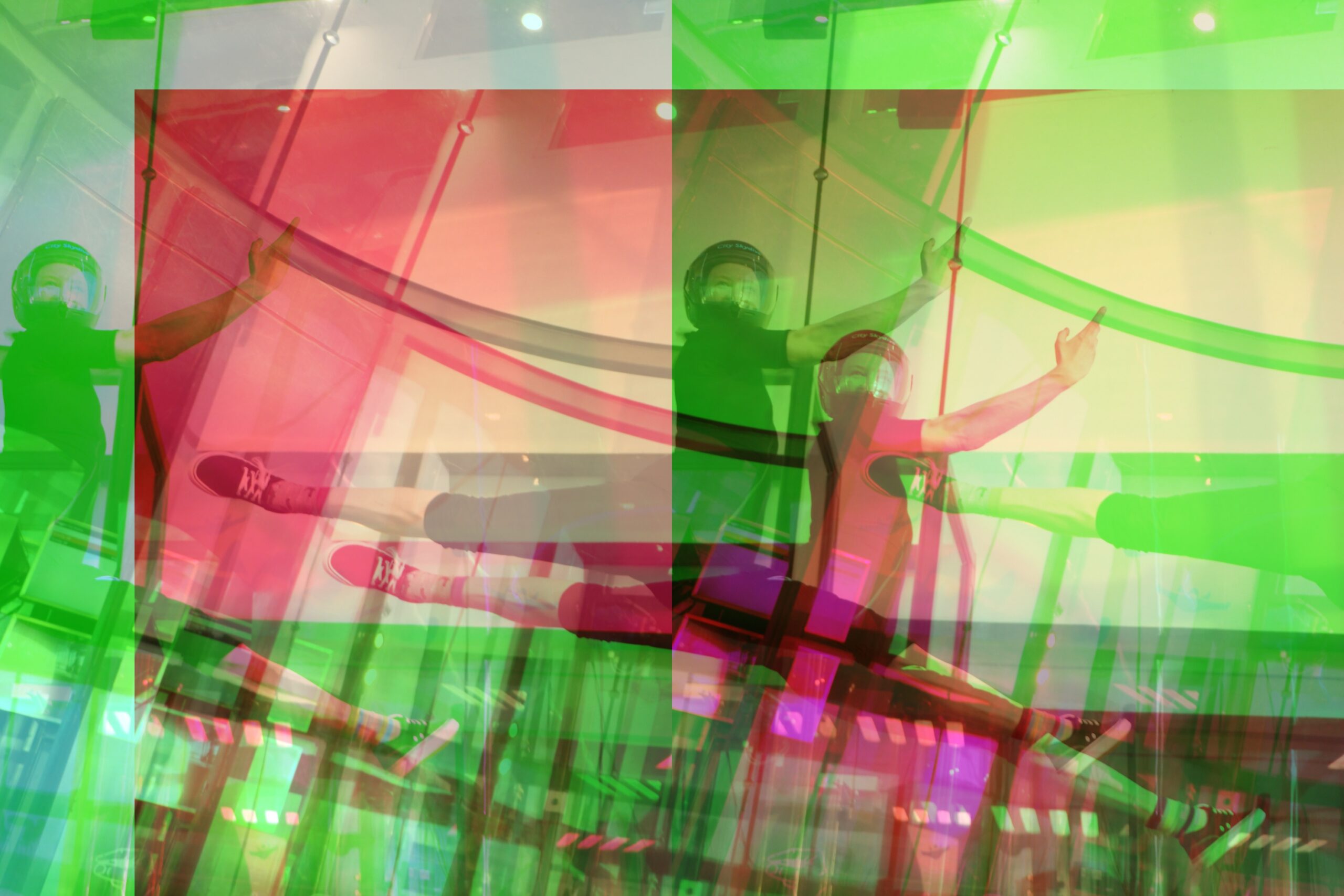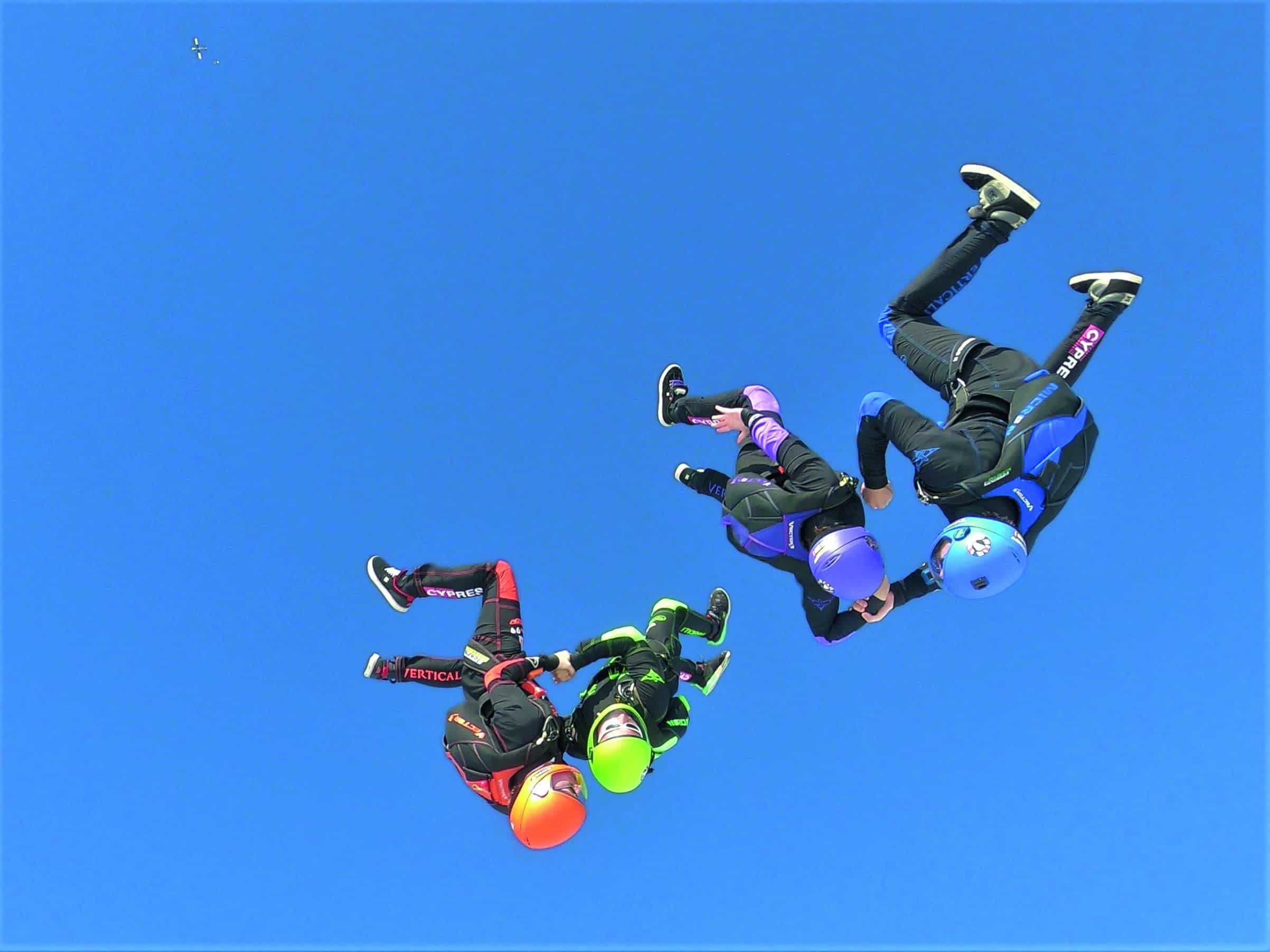“You can change the axis, the orientation, the movement, even the position… but at the end of the day, it’s all just barrel rolls”
– Naomi Kotzee
By Connor Figg
Ah, freestyle flying: that pointy-toed fringe discipline for contortionists.
…Or is it?
Spoiler alert: it is not.
Myths and preconceptions may abound, but there’s no question that freestyle flying is art. It’s an expression of oneself using movement and freedom. The fun part is that this discipline is for absolutely everyone – and the more you take notice of what these skills can do for you as a flyer, the better off you’ll be. The little notes and bits of flair that separate your flying from someone else’s – whether you are flying FS four-Way, VFS or dynamic, that is your “free” style. To be a truly great flyer, you’ll need to nurture it, grow it and – well – play around a little.
Here’s how.
WHAT IS FREESTYLE, ANYWAY?
Freestyle and dynamic flying have often been a little hard to differentiate for those who don’t actively pursue them – so let’s cover the background and get a solid definition before we really dive in.
Dynamic flying is all about speed and efficiency. You can think about it like you’re running a race. It doesn’t matter what you do between the start and finish lines, as long as you are moving between the two as fast as possible while staying within the rules.
This means that almost every dynamic flyer uses similar techniques because, over time, the community have collectively honed in on the perfect flying shapes to maximise lift and speed. Dynamic flying movements are big and powerful, designed to use as much of the space as possible. Even when teams are creating dynamic free routines together (where they can fly anything they want, instead of the set patterns of speed rounds) the routines all tend towards speed and power. This can come at the cost of creativity.
In comparison to that straightforward line between the first and final seconds of a dynamic flying session, the nature of freestyle flying is really quite difficult to pin down. It represents so many different things to different people. It’s trick flying – dizzying breakers and flip twists that leave you reeling. It’s also delicate, precise movements, like static side flying – an almost indescribably unstable position, balanced only through incredibly fine control of the body. Others like to play around with flying different shapes in the wind just to see how they feel and rotate, how they access power in unpredictable ways, or to demonstrate their flexibility (here’s to you, contortionists). The beauty of freestyle is how many different ways there are to express yourself, and how new ways are being developed all the time.
Even so, dynamic flying and freestyle flying are not separate arts. A strong flyer will have an understanding and an appreciation of how to use space and create power through practising their dynamic flying, and will be able to weave this into the freestyle elements they wish to demonstrate. In competition, the highest-scoring flyers will always be the ones who are able to demonstrate a mastery of all of the techniques described here.
THE UK FREESTYLE COMPETITION SCENE
In competition, freestyle consists of two different types of round.
First, there is the free round, lasting between 75 and 90 seconds and often set to music, where the athlete may perform any move or element they wish in order to impress the judges.
Then there are the compulsory rounds. These consist of two different rounds of 45 seconds each, where the performer must perform six different, predetermined moves, linked together as smoothly as possible. These moves are notoriously difficult to perform on even a basic level, let alone well, and are often seen as the high bar which must be surpassed in order for an aspiring freestyler to begin competing. They feature HD flying, multiple flips and flip twists, and are specifically designed to demonstrate the prowess of the best flyers in the world. All this is very useful for those competing at the highest levels, but incredibly restrictive for anyone wishing to perform their own take on freestyle to others in competition.
For the past few years, the UK Indoor skydiving Nationals have taken a different approach to freestyle competition. Rather than forcing every hopeful competitor to first learn the compulsory moves, the organisers have instead opted to leave the compulsory rounds out and instead focus only on the free round. This opens the competition up to literally anyone who has a basic grasp of tunnel flying, and is an incredible opportunity for more flyers to showcase their flying and their unique styles. So, regardless of your level, if you’ve ever thought about entering a freestyle competition, this is your chance!
FREESTYLE ISN’T ABOUT COMPETITION. IT’S ABOUT ARTISTIC EXPRESSION.
Now, although much has been said about freestyle in its competition format, there are many among you who wouldn’t consider this your scene. There’s a lot of stress involved in competition, and this certainly isn’t everyone’s cup of tea. I would still argue that freestyle is for you.
Freestyle isn’t about competition. It’s artistic expression in its most pure form. The clue is in the name: free!
Freestyle flying is like dancing. Anything you have ever seen a dancer do on the floor, you can do in the wind… and so much more, besides. The wind is the ultimate creative tool. It’s a 3D canvas upon which you paint with your body and express yourself in any way you choose. You may choose to take classes and learn to use your tools more effectively, but at the end of the day, you’re the one holding the brush. You certainly don’t need to be a shredder to start developing your own style. You can start freestyling anytime you like by experimenting with some unusual flight positions.
FIRST EXPERIMENTS FOR THE FREESTYLE-CURIOUS
With that in mind, here’s a little exercise for you to try next time you’re in the wind. (Don’t worry, as long as you can fly stably on your belly, you can give this a go – although it’s always worth giving your instructor and/or coach a heads-up first!)
- Drop a Knee
The first step is to drop a knee. This can be harder than it looks! When you push a knee below your hips, even the smallest change in the angle will have a huge effect and start you turning very quickly.
If you feel like you’re struggling to get your knee at the right angle, practise tapping your knee underneath you with your opposite hand. This will help centre everything and show you how close to your centre of gravity you will have to bring the knee. When done correctly, the foot of your dropped knee should be touching the other knee.
Practise while holding onto your coach or instructor to help stabilise yourself. When you can hold this position without turning, you can move onto the next step.
- Cross Your Ts
Now you can control your knee in a dropped position, it’s time to straighten the knee and get your leg fully stretched below you. The fine controls you developed to keep your knee under you will need to get a whole lot finer to balance this. You will also need to stretch out your other leg behind and widen your arms to help keep balanced. Voilà! Look at you, ya ninja… you’re flying a T-pose!
- Take it For a Spin
Now finally, let’s spin it. If you have your right leg dropped, you’ll often find it easier to spin to your left. By slightly bending the leg stretched out behind you, you’ll find that your body will follow that leg around. Now you’re flying a move that has featured in freestyle competitions since the dawn of the sport!
By playing around with this position, you can learn a huge range of other things: for example, carving it outface around the wall, switching the legs mid spin to change direction in a “running man” shape, as well as changing the angle of your torso to smoothly transition to a HU position. Play with it. See what you can make it do. This is the fun part.
GET CREATIVE, BUT KEEP IT SAFE
With all of this stuff, experimentation is key. But generally, experimentation requires a little trial and error.
If you’re trying new things, you are, by definition, not going to know what will happen. In the tunnel, errors can very quickly translate into injuries, so we all need to take steps to make sure we leave the tunnel with more or less the same number of limbs and bruises as we started with.
The first and most important thing we can do when trying new things is get some expert help. Not only will a coach help keep you safe in the wind, but they can also help guide you as you develop your signature moves and your characteristic flair. Whatever position or trick you may be trying to learn, they have almost certainly already spent an inordinate amount of time making every mistake imaginable so that they now understand these different positions inside and out. They can save you a lot of frustration by pointing out the tiny changes necessary to make a position (or move) really fly!
And that, at the end of the day, is what this “freestyle” thing is all about: really flying, as only you can.

Bio:
Connor has been zooming around the globe, coaching freefly in various tunnels and bits of sky for most of the last decade. He has earned a healthy selection of National Champion titles in Freestyle and Dynamic flying and has consistently ranked in the top 10 at the latest World meets. He now lives in the Netherlands with his partner-teamies and spends most of his time wishing he had a cat.
If you would like to join Connor at one of his future tunnel camps, feel free to shoot him a message on Facebook. He promises he won’t bite.
Want to find more stories like this? Download the official Skydive the Mag app on either apple or android. Don’t want to download? Don’t worry. You can read the online version here.





